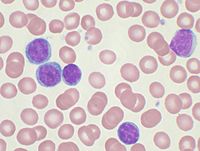
Photo from wikipedia
patients with non-surgical stage disease (n1⁄410); 2) imprinted cytological samples from positive mediastinoscopies during the intraoperative staging of patients with lung cancer (n1⁄411); 3) positive pleural fluid in patients with… Click to show full abstract
patients with non-surgical stage disease (n1⁄410); 2) imprinted cytological samples from positive mediastinoscopies during the intraoperative staging of patients with lung cancer (n1⁄411); 3) positive pleural fluid in patients with pulmonary nodule (n1⁄42). Then we performed FISH technique, evaluated the quality of the signal obtained, and compared the results with those obtained on paraffin sections. FISH technique on paraffin blocks was performed using 2XSSC/ proteinase K pretreatment as standardized by our lab. Cytology smears were destained and fixed in 10% methanol and incubated with FISH probe (ALK, ROS1 and MET). Result: All cytology cases had scorable signals and were easy to interpret. Also, as no pretreatment was required, assay time was shorter. Depending on cellularity, one same slide was useful for analysis of the three probes. When comparing with IHC and FISH studies, we obtained a 100% correlation with ALK (n1⁄423; positive1⁄42, negative1⁄421), ROS1 (n1⁄45, all negative) and MET (n1⁄45, all negative). Conclusion: This work allowed us to optimize the use of different cytology samples frequently available in advance stage NSCLC for FISH studies. The use of cytological material might improve turnaround time for results and can become a useful tool in pathology labs, in particular when paraffin included material is limited. Keywords: cytology, FISH
Journal Title: Journal of Thoracic Oncology
Year Published: 2018
Link to full text (if available)
Share on Social Media: Sign Up to like & get
recommendations!